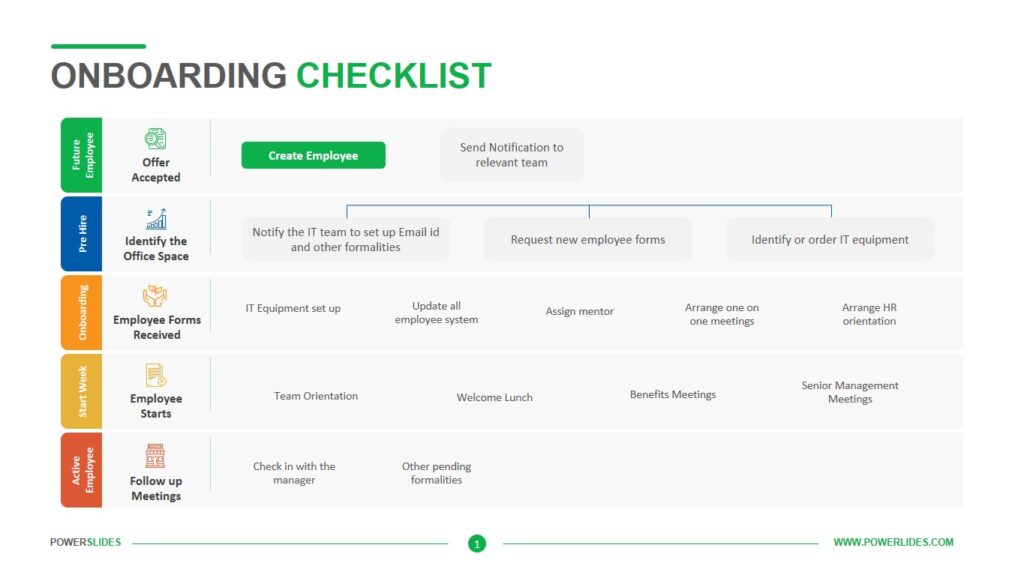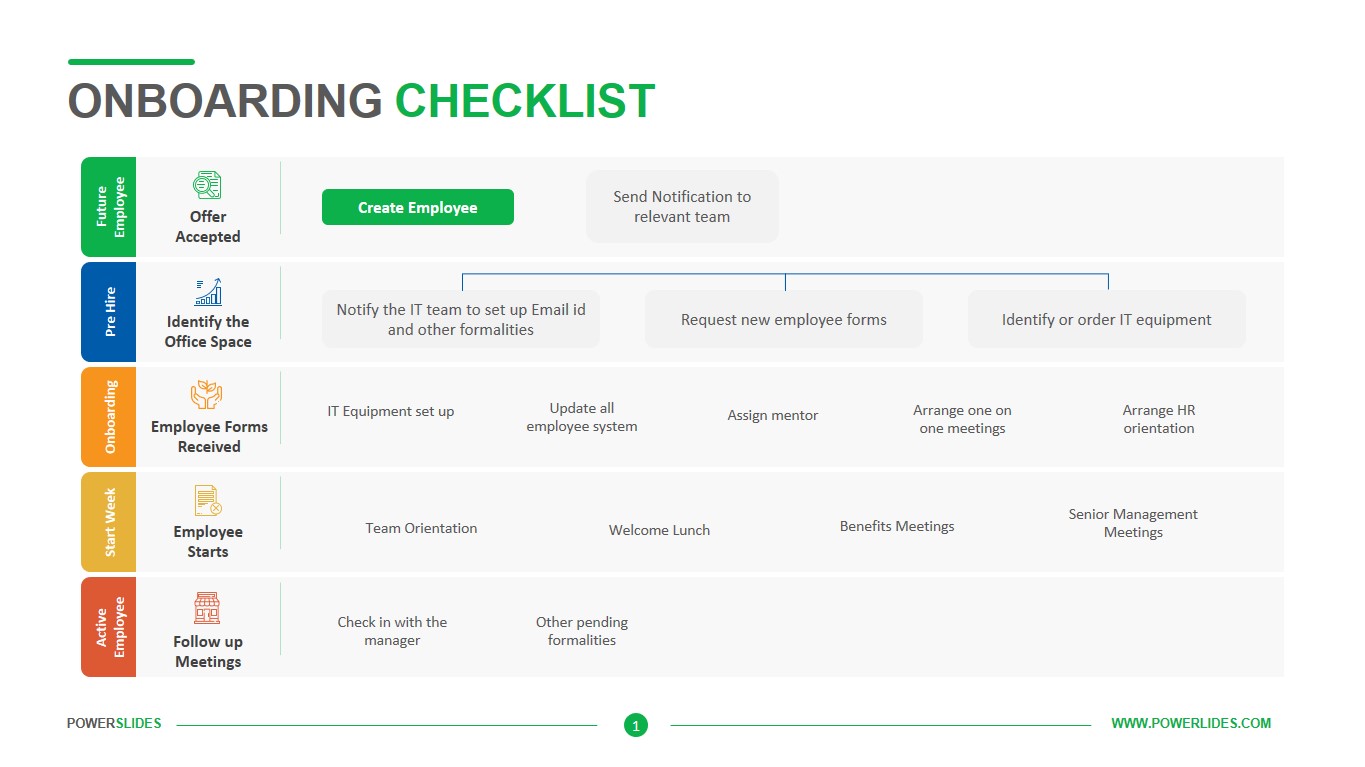
The Ultimate Onboarding Checklist for New Employees Template
Starting a new job can be both exciting and overwhelming. For employers, ensuring a smooth and structured onboarding process is crucial for setting new hires up for success. A comprehensive onboarding checklist for new employees template is the cornerstone of an effective onboarding strategy. This article delves into the essential elements of such a template, offering insights and best practices to optimize your onboarding process and foster a positive employee experience.
Why Use an Onboarding Checklist?
An onboarding checklist serves as a roadmap for both the new employee and the onboarding team. It provides structure, ensures consistency, and helps track progress. Here are some key benefits:
- Improved Employee Engagement: A well-structured onboarding process makes new employees feel welcomed and valued, boosting engagement from day one.
- Reduced Time to Productivity: By providing clear expectations and necessary resources, an onboarding checklist accelerates the time it takes for new hires to become productive.
- Enhanced Retention Rates: A positive onboarding experience significantly increases the likelihood of retaining new employees.
- Consistency and Standardization: An onboarding checklist for new employees template ensures that all new hires receive the same essential information and training, regardless of their department or role.
- Reduced Errors and Omissions: By following a checklist, onboarding teams can minimize the risk of overlooking crucial steps.
Key Components of an Effective Onboarding Checklist
A robust onboarding checklist should cover all critical aspects of the new employee’s integration into the company. Here’s a breakdown of the key components:
Pre-First Day Tasks
- Send a Welcome Package: This could include company swag, a welcome letter from the CEO, and essential information about the company culture.
- Prepare the Workspace: Ensure the employee’s workstation is ready with all necessary equipment and supplies.
- Set Up IT Infrastructure: Create email accounts, provide access to relevant software, and ensure network connectivity.
- Complete Paperwork: Send necessary forms (e.g., tax forms, benefit enrollment forms) electronically for completion before the first day.
- Introduce the Team: Send an email introducing the new hire to their team members.
First Day Activities
- Welcome and Introductions: Greet the new employee warmly and introduce them to key team members and stakeholders.
- Office Tour: Familiarize the new hire with the office layout, including restrooms, break rooms, and meeting rooms.
- Review Company Policies: Provide an overview of important company policies, such as attendance, dress code, and code of conduct.
- Set Expectations: Clearly define the employee’s role, responsibilities, and performance expectations.
- Initial Training: Provide introductory training on essential tools and processes.
First Week Activities
- In-Depth Training: Provide more detailed training on specific tasks and responsibilities.
- Team Meetings: Schedule meetings with key team members for introductions and project discussions.
- Performance Goals: Establish initial performance goals and metrics.
- Mentorship Program: Assign a mentor to provide guidance and support.
- Feedback Session: Schedule a check-in meeting to gather feedback on the onboarding process and address any concerns.
First Month Activities
- Regular Check-ins: Conduct regular check-ins to monitor progress and provide ongoing support.
- Performance Review: Conduct a formal performance review to assess progress and identify areas for improvement.
- Training and Development: Offer opportunities for ongoing training and development.
- Social Integration: Encourage the new employee to participate in team-building activities and social events.
- Gather Feedback: Solicit feedback on the onboarding process and make adjustments as needed.
Ongoing Activities
- Continuous Feedback: Provide ongoing feedback and support to ensure continued growth and development.
- Performance Management: Implement a robust performance management system to track progress and identify areas for improvement.
- Career Development: Offer opportunities for career advancement and professional development.
- Stay Engaged: Continuously seek ways to keep employees engaged and motivated.
Creating Your Own Onboarding Checklist Template
While numerous onboarding checklist for new employees template options are available online, customizing one to fit your specific organizational needs is crucial. Here are some tips for creating your own template:
- Identify Key Tasks: Brainstorm all the essential tasks that need to be completed during the onboarding process.
- Categorize Tasks: Group tasks into logical categories, such as pre-first day, first day, first week, and first month.
- Assign Responsibility: Clearly assign responsibility for each task to a specific individual or team.
- Set Deadlines: Establish realistic deadlines for each task.
- Use a Tracking System: Implement a system for tracking progress and ensuring that all tasks are completed on time.
- Gather Feedback: Solicit feedback from new employees and the onboarding team to identify areas for improvement.
- Regularly Review and Update: Regularly review and update the onboarding checklist for new employees template to ensure that it remains relevant and effective.
Tools and Resources for Onboarding
Several tools and resources can help streamline the onboarding process and make it more efficient. These include:
- Onboarding Software: These platforms automate many onboarding tasks, such as sending welcome emails, assigning training modules, and tracking progress.
- Learning Management Systems (LMS): LMS platforms provide a centralized location for delivering training materials and tracking employee progress.
- HR Information Systems (HRIS): HRIS systems can help manage employee data, track performance, and streamline HR processes.
- Collaboration Tools: Tools like Slack and Microsoft Teams can facilitate communication and collaboration between new employees and their teams.
- Document Management Systems: These systems help organize and manage important onboarding documents, such as employee handbooks and training materials.
Examples of Onboarding Checklist Templates
Many websites offer free or paid onboarding checklist for new employees template options. Here are a few examples:
- Microsoft Office Templates: Microsoft offers a variety of free onboarding checklist templates for Word and Excel.
- HR Software Providers: Many HR software providers offer onboarding checklist templates as part of their software packages.
- Project Management Tools: Project management tools like Asana and Trello can be used to create and manage onboarding checklists.
Common Onboarding Mistakes to Avoid
Even with a well-designed onboarding checklist, it’s important to be aware of common onboarding mistakes and take steps to avoid them. These include:
- Lack of Preparation: Failing to prepare the workspace and IT infrastructure before the new employee’s arrival.
- Information Overload: Bombarding new employees with too much information too quickly.
- Lack of Communication: Failing to communicate expectations clearly and provide regular feedback.
- Neglecting Culture: Failing to introduce new employees to the company culture and values.
- Ignoring Feedback: Failing to solicit and act on feedback from new employees.
The Future of Onboarding
The future of onboarding is likely to be more personalized, data-driven, and technology-enabled. Companies will increasingly use data analytics to track the effectiveness of their onboarding programs and make adjustments as needed. They will also leverage technology, such as virtual reality and artificial intelligence, to create more immersive and engaging onboarding experiences. An effective onboarding checklist for new employees template will remain a critical component, but it will be enhanced by these new technologies.
Conclusion
A well-structured onboarding checklist for new employees template is an indispensable tool for creating a positive and productive onboarding experience. By following the guidelines outlined in this article, organizations can ensure that new hires are properly integrated into the company, equipped with the knowledge and resources they need to succeed, and more likely to stay with the company long-term. Remember to customize your onboarding checklist to fit your specific organizational needs and to regularly review and update it to ensure that it remains relevant and effective. Implement the right tools, avoid common mistakes, and embrace the future of onboarding to create a truly exceptional experience for your new employees. Remember, a great start is half the battle won. [See also: Employee Retention Strategies] [See also: How to Improve Employee Engagement]

